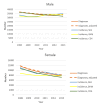HIV Trends in the United States: Diagnoses and Estimated Incidence
- PMID: 28159730
- PMCID: PMC5315764
- DOI: 10.2196/publichealth.7051
HIV Trends in the United States: Diagnoses and Estimated Incidence
Abstract
Background: The best indicator of the impact of human immunodeficiency virus (HIV) prevention programs is the incidence of infection; however, HIV is a chronic infection and HIV diagnoses may include infections that occurred years before diagnosis. Alternative methods to estimate incidence use diagnoses, stage of disease, and laboratory assays of infection recency. Using a consistent, accurate method would allow for timely interpretation of HIV trends.
Objective: The objective of our study was to assess the recent progress toward reducing HIV infections in the United States overall and among selected population segments with available incidence estimation methods.
Methods: Data on cases of HIV infection reported to national surveillance for 2008-2013 were used to compare trends in HIV diagnoses, unadjusted and adjusted for reporting delay, and model-based incidence for the US population aged ≥13 years. Incidence was estimated using a biomarker for recency of infection (stratified extrapolation approach) and 2 back-calculation models (CD4 and Bayesian hierarchical models). HIV testing trends were determined from behavioral surveys for persons aged ≥18 years. Analyses were stratified by sex, race or ethnicity (black, Hispanic or Latino, and white), and transmission category (men who have sex with men, MSM).
Results: On average, HIV diagnoses decreased 4.0% per year from 48,309 in 2008 to 39,270 in 2013 (P<.001). Adjusting for reporting delays, diagnoses decreased 3.1% per year (P<.001). The CD4 model estimated an annual decrease in incidence of 4.6% (P<.001) and the Bayesian hierarchical model 2.6% (P<.001); the stratified extrapolation approach estimated a stable incidence. During these years, overall, the percentage of persons who ever had received an HIV test or had had a test within the past year remained stable; among MSM testing increased. For women, all 3 incidence models corroborated the decreasing trend in HIV diagnoses, and HIV diagnoses and 2 incidence models indicated decreases among blacks and whites. The CD4 and Bayesian hierarchical models, but not the stratified extrapolation approach, indicated decreases in incidence among MSM.
Conclusions: HIV diagnoses and CD4 and Bayesian hierarchical model estimates indicated decreases in HIV incidence overall, among both sexes and all race or ethnicity groups. Further progress depends on effectively reducing HIV incidence among MSM, among whom the majority of new infections occur.
Keywords: HIV infections; United States; biomarkers; incidence.
©H Irene Hall, Ruiguang Song, Tian Tang, Qian An, Joseph Prejean, Patricia Dietz, Angela L Hernandez, Timothy Green, Norma Harris, Eugene McCray, Jonathan Mermin. Originally published in JMIR Public Health and Surveillance (http://publichealth.jmir.org), 03.02.2017.
Conflict of interest statement
Conflicts of Interest: None declared.
Figures



References
-
- Hall HI, Song R, Rhodes P, Prejean J, An Q, Lee LM, Karon J, Brookmeyer R, Kaplan EH, McKenna MT, Janssen RS, HIV Incidence Surveillance Group Estimation of HIV incidence in the United States. J Am Med Assoc. 2008 Aug 6;300(5):520–9. doi: 10.1001/jama.300.5.520. http://europepmc.org/abstract/MED/18677024 300/5/520 - DOI - PMC - PubMed
-
- Centers for Disease Control and Prevention CDC. 2012. [2016-11-25]. HIV Surveillance Supplemental Report 17(4) http://www.cdc.gov/hiv/library/reports/hiv-surveillance.html . - PubMed
-
- Chen M, Rhodes PH, Hall IH, Kilmarx PH, Branson BM, Valleroy LA. Prevalence of undiagnosed HIV infection among persons aged ≥13 years--National HIV Surveillance System, United States, 2005-2008. MMWR Morb Mortal Wkly Rep. 2012 Jun 15;61(2):57–64. http://www.cdc.gov/mmwr/preview/mmwrhtml/su6102a10.htm su6102a10 - PubMed
-
- Centers for Disease Control and Prevention CDC. 2016. [2016-11-25]. HIV Surveillance Supplemental Report 21(4) http://www.cdc.gov/hiv/library/reports/hiv-surveillance.html . - PubMed
-
- Aidsinfo.nih. 2015. Apr 8, [2015-10-19]. Guidelines for the use of antiretroviral agents in HIV-1-infected adults and adolescents http://aidsinfo.nih.gov/contentfiles/lvguidelines/AdultandAdolescentGL.p... .
LinkOut - more resources
Full Text Sources
Other Literature Sources
Research Materials
Miscellaneous

